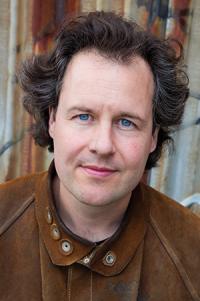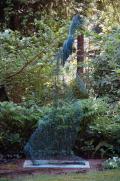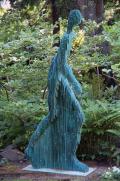The Quantum Sculptor
Fall
2013
Spotlight on Hidden Physicists
The Quantum Sculptor
Julian Voss-Andreae, Sculptor
 I have always loved reading popular science magazines. But I really got hooked on physics after reading Roger Penrose’s amazing book, The Emperor’s New Mind.
I have always loved reading popular science magazines. But I really got hooked on physics after reading Roger Penrose’s amazing book, The Emperor’s New Mind.
I had moved from my hometown, Hamburg, to Berlin in Germany, with the plan to study painting, but this book gave me my first real glimpse of quantum physics. Deeply fascinated, I decided to find out as much as I could about the subject by studying physics at the Freie Universität Berlin. Later, I moved to Vienna, Austria, for my graduate thesis work with Anton Zeilinger, probably best known for the first realization of quantum teleportation.
In Vienna, I participated in the setup of a new type of experiment, one that was actually first suggested by Roger Penrose. We sent carbon-60 “buckyballs” through a double-slit experiment in 1999, recording a clear diffraction pattern and demonstrating that a single buckyball (or, more accurately, the entity that is later detected as a single buckyball) goes through two openings at once—two openings a hundred times farther apart than the diameter of one buckyball. Our buckyballs were the most massive particles ever probed for wavelike behavior.
Although fully committed to physics at the time, I had never given up on the idea of making art again one day. Shortly after the Vienna experiment, I attended a conference in Cortona, Italy, for scientists who wanted to explore the arts, humanities, and spirituality. One speaker, George Weissmann, especially fascinated me with his talk, “Quantum Physics and Parapsychology.” His daughter, Adriana, would exert an even stronger influence on me, compelling me soon after to move to Portland to be with her.
I felt the urge to return to art, bringing with me what I had learned and experienced in physics. I enrolled in an art school, with a focus on sculpture, and soon found myself making sculptures based on the structure of proteins, the molecular building blocks of life. Last month I installed the latest such protein sculpture, a 20-foot stainless steel and colored glass piece based on the structure of the human collagen molecule, at Rutgers University in New Jersey.
A different body of my work draws inspiration directly from quantum physics to create novel sculptures. The 2009 exhibition “Quantum Objects” at the American Center for Physics in College Park, Maryland, was devoted solely to this body of work. One of the first sculptures in this series, “Quantum Man,” envisions a walking human figure as a quantum object.
Today I am working on a large-scale commission based on a similar idea for the University of Minnesota’s new Physics and Nanotechnology Building in Minneapolis. Two monumental figures, a kneeling man and a woman each 10 feet tall, face each other on a plaza over a distance of sixty feet. They are fabricated from parallel slabs of steel arranged in such a way that the figures almost disappear from view when the viewer crosses through the line of their gaze.
I am also part of a team that recently won a $2 million National Science Foundation grant to develop cutting-edge nanomaterials built from DNA. My part is to find ways to visualize the nanostructures we are going to build in the lab as macroscopic sculptural objects. This project is my first real science-related work in over a decade, drawing on my experiences both as a scientist and as an artist.
More from this Department
Spotlight on Hidden Physicists




